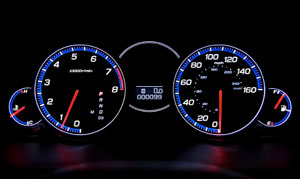 Dials and gauges are disappearing from automobiles in favor of digital displays. Light Emitting Diode (LED) and Liquid Crystal Displays (LCD) first began appearing in automobiles in the late 1970s. The early displays were generally limited to displaying a limited set of numbers and letters. LED displays had the advantage of generating their own light. LCD displays required an external light source to be viewable in the dark. The early LED displays were nearly always red (the brightest and most energy efficient color available at the time) and didn't produce enough light to be easily visible on a sunny day. LCD displays were black on gray, suffered from temperature sensitivity, and had a limited viewing angle. Vacuum-fluorescent displays appeared in automobiles in the early 1980s. These displays were brighter than LED displays and were available in more colors.
Dials and gauges are disappearing from automobiles in favor of digital displays. Light Emitting Diode (LED) and Liquid Crystal Displays (LCD) first began appearing in automobiles in the late 1970s. The early displays were generally limited to displaying a limited set of numbers and letters. LED displays had the advantage of generating their own light. LCD displays required an external light source to be viewable in the dark. The early LED displays were nearly always red (the brightest and most energy efficient color available at the time) and didn't produce enough light to be easily visible on a sunny day. LCD displays were black on gray, suffered from temperature sensitivity, and had a limited viewing angle. Vacuum-fluorescent displays appeared in automobiles in the early 1980s. These displays were brighter than LED displays and were available in more colors.
Modern automobiles have many digital displays. Many of these are high-resolution
flat panel displays that are capable of displaying images. These images may include text, numbers,
maps, menus or even digital representations of traditional analog gauges. Automotive flat panel displays generally
employ one of three technologies: LCD-TFT, LED or OLED.
LCD-TFT Displays: Thin film transistor LCD displays employ an advanced form of liquid crystal technology. TFT flat panel displays are arrays of active transistors that twist the polarization of light passing between two polarizing filters when they are activated. When a transistor is on, the light passes through both filters and the pixel is illuminated. When the transistor is off, no light passes and the pixel is dark. TFT displays are commonly used on laptop computers because they can have an extremely high-resolution and are relatively energy efficient.
LED Displays: Unlike LCD-TFT displays, LED displays generate their own light and are generally much brighter with a greater contrast ratio. Flat panel LED displays are arrays of light emitting diodes. Because LEDs can only be made so small, maximum resolution is limited. Thus, these LED displays lend themselves to large-format displays, generally designed to be viewed at a distance, such as sporting event screens and monikers on buses. Compared to 1970's LED technology, today's LEDs are available in a much wider range of colors. The combination of red, green, and blue LEDs allows display designers to produce a wide color gamut. Interestingly, one of the oldest digital display technologies is now used to market the newest flat panel display technologies. New "LED-TVs" are back-lit LCD screens that use white or tri-color LED's rather than fluorescent bulbs. This has allowed TVs and other displays to become much thinner and have higher contrast.
OLED Displays: OLED is an acronym for Organic Light Emitting Diode. OLED displays are high-resolution arrays of light emitting diodes printed on an organic substrate. They have several advantages over LCD-TFT displays. They are thinner, more flexible, consume less power for a given display brightness, have a wider viewing angle and exhibit enhanced color saturation. However, they are difficult to manufacture in large sizes and are relatively expensive.

